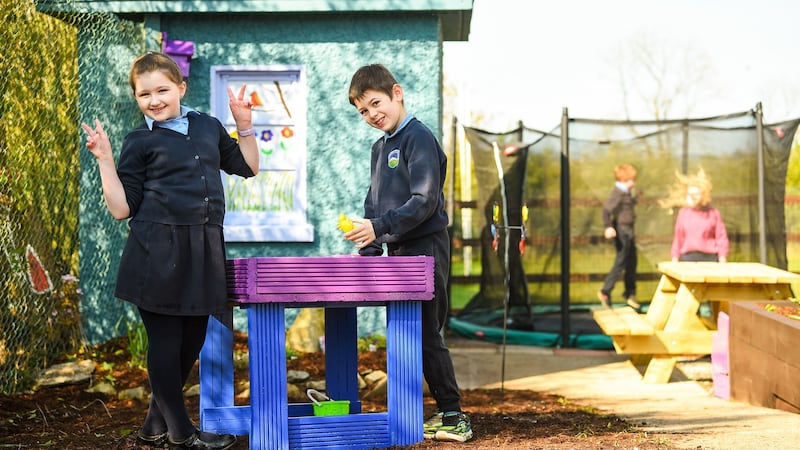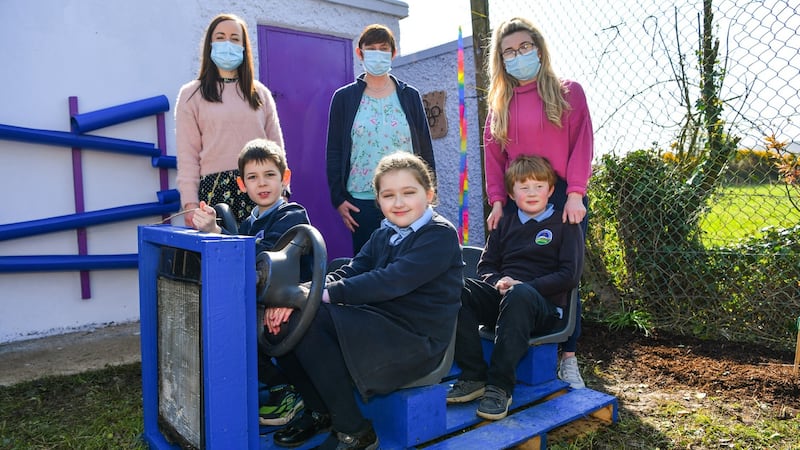While for many children, yard time is their favourite part of the school day, the noise and chaos can be overwhelming for children with autism. That's why Anglesboro National School is transforming its yard by installing a sensory garden, trampoline and colourful flowers.
"We already have a sensory room, but we feel that it would be nice for the children to have an outdoor space alongside the yard, so they have an area to go to, if they need it," says Maria Murphy, teacher of the autism class at Anglesboro.
The sensory garden is just one of the changes Murphy hopes to introduce to the school as part of the Autism Friendly Schools project. Introduced by the autism charity AsIAm, the programme aims to support schools in creating a more inclusive school culture for its students with autism.
Given that most of the estimated one in 65 children with autism in Ireland attend mainstream schools, it is a challenge facing thousands of education settings.
Murphy says she got involved in the project to access continuous professional development and find out more about best practice in relation to autism from people who had experience in the area.
“We wanted, as a whole school, to get guidelines on best practice and to encourage autism understanding and acceptance,” she says.
Hannah O’Dwyer, education officer at AsIAm, says it is important for schools to look at the whole school building if they are trying to create an environment that is truly inclusive for students with autism.
“It’s not just the particular class that the child goes to,” says O’Dwyer. “If you just make particular parts of the school autism friendly, then you are confining your child to those areas; they are still not able to access the school hall or a particular corridor, so it really needs to be a school-wide project.”
Online toolkit
The charity has an online toolkit which can be used to provide a sensory audit of a school. O’Dwyer recommends involving autistic and neurotypical students in this audit on the basis that it helps create awareness and can be a validating experience for students with autism.
“It is a lovely exercise in itself to help them be aware that people experience things differently,” says O’Dwyer. “Particularly for younger, autistic children, they don’t necessarily know that someone is experiencing something differently from them.”
At Anglesboro, teachers have found that creating awareness within the school is just as important as any adaptations they make to the physical building. “We would like to teach them, not even just about autism, but about difference and what difference is,” says Murphy.
In doing so, school becomes a more understanding environment for everyone which, in turn, boosts learning.

“It’s okay if they find that the noise level is too loud and need to go to the sensory room. They are aware and it makes them more comfortable in themselves. It is when they are happy and comfortable that the learning can take place.”
The Autism Friendly Schools programme is open to both primary and post-primary schools.
I have a bug bear with the word 'unit'. It infuriates me when I hear leaders using that word - that medicalising of an educational environment is really dangerous
"The more we work with primary and secondary, the better the experience is going to be, especially for the young child who is coming in with an additional need," says Billy Redmond, school principal and project co-ordinator for the programme. "We are trying to build a real sense that we are in this together."
A key focus, he says, is examining the strengths that schools have instead of “creating a list of what we are doing wrong”.
“It is about identifying one or two targets that are specifically going to be helpful to the students we have; it is about being strengths based and solution focused,” he says.
Student passports
Teachers Rebecca Lawlor and Aoife McArdle took this approach when they signed their school, Bremore Educate Together, in Balbriggan, up to the programme. "We focused on student passports," says Lawlor. "Getting to know the students not just because of their needs but because of their interests as well."
These passports helped promote inclusivity by giving the students a voice.
“It’s inclusive education, adapting the curriculum to the students’ needs and desires, and making sure we are growing their interests,” says McArdle, who teaches the autism class at Bremore. “It is more holistic and it is making them feel heard so that they are not afraid to achieve or feel held back at all.”
The school has also introduced a standardised display of lesson layout, resources needed and homework due dates on whiteboards in all classrooms.
“It means there is no unpredictability that could cause confusion or anxiety,” says McArdle. “It benefits everyone.”
Lawlor says this consistency of approach supports the entire school community.
“They are finding it very supportive and it is subtly done,” she says. “The students themselves are probably not aware of the programme but they are aware of the benefit that is there for their own learning.”
Use of language
Another key area the programme aims to tackle is in the area of language.
“I have a bugbear with the word ‘unit’,” says Redmond. “It infuriates me when I hear leaders using that word - that medicalising of an educational environment is really dangerous.”

O’Dwyer says there is a disconnect between the language promoted by organisations, such as AsIAm, and language used by Government and educational bodies.
"You see in Government documents and documents by educational psychologists that they look at it from a much more medical model," says O'Dwyer. "Even through teacher education, I am sure it is still being called Autism Spectrum Disorder and still being presented as this checklist of things that are wrong. When you think about that logically, it is really difficult to help a person if you are just looking at a list of things that they can't do."
It is hard to do everything, from occupational therapy to speech and language therapy and teach
While many schools and teachers are keen to do more to support children with autism, a recent study from Lorna Barry of University of Limerick indicates that many teachers do not receive adequate training in relation to autism.
As a result, evidence-based practices are not being employed consistently when teaching students with autism.
She found that 33 per cent of teachers surveyed had no autism training. Teachers interviewed for the study said they faced challenges such as accessing on-time, over-subscribed training courses or training that wasn’t meeting some of their needs.
“What we were finding as well from our research is that teachers were not able to access support from external professionals as much as they needed,” says Barry.
Murphy, for example, says she received no training or experience in an autism class when she was at college.
“So you are newly put into the classroom and you have no training. You are trying to find your feet and you are trying to do the training during the year, it is not ideal,” she says.
“It is such a broad area and you need support from other people, it is hard to do everything, from occupational therapy to speech and language therapy and teach.”
Yet, the use of evidence-based practices improves educational outcomes for students with autism. “It can also be linked to less stress and less burnout for the teachers having those improved outcomes for the student,” says Barry.
Her study suggests that teachers need more access to training along with a broader range of ongoing supports to assist them with the successful implementation of evidence-based practices.
“When we have 63 per cent of our autistic students now being educated in a mainstream classroom, it is really important for mainstream teachers to be made aware of these practices and to be supported in implementing them to facilitate that inclusive education,” says Barry.











